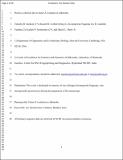| dc.contributor.author | Sackton, Timothy | |
| dc.contributor.author | Corbett-Detig, Russell B. | |
| dc.contributor.author | Nagaraju, Javaregowda | |
| dc.contributor.author | Vaishna, Lakshmi | |
| dc.contributor.author | Arunkumar, Kallare P. | |
| dc.contributor.author | Hartl, Daniel L. | |
| dc.date.accessioned | 2015-10-02T15:03:40Z | |
| dc.date.issued | 2014 | |
| dc.identifier.citation | Sackton, Timothy B., Russell B. Corbett-Detig, Javaregowda Nagaraju, Lakshmi Vaishna, Kallare P. Arunkumar, and Daniel L. Hartl. 2014. “Positive Selection Drives Faster-Z Evolution in Silkmoths.” Evolution 68: 2331–2342. doi:10.1111/evo.12449. | en_US |
| dc.identifier.issn | 0014-3820 | en_US |
| dc.identifier.uri | http://nrs.harvard.edu/urn-3:HUL.InstRepos:22907486 | |
| dc.description.abstract | Genes linked to X or Z chromosomes, which are hemizygous in the heterogametic sex, are predicted to evolve at different rates than those on autosomes. This “faster-X effect” can arise either as a consequence of hemizygosity, which leads to more efficient selection for recessive beneficial mutations in the heterogametic sex, or as a consequence of reduced effective population size of the hemizygous chromosome, which leads to increased fixation of weakly deleterious mutations due to genetic drift. Empirical results to date suggest that, while the overall pattern across taxa is complicated, systems with male heterogamy show a faster-X effect attributable to more efficient selection, whereas the faster-Z effect in female-heterogametic taxa is attributable to increased drift. To test the generality of the faster-Z pattern seen in birds and snakes, we sequenced the genome of the lepidopteran silkmoth Bombyx huttoni. We show that silkmoths experience faster-Z evolution, but unlike in birds and snakes, the faster-Z effect appears to be attributable to more efficient positive selection. These results suggest that female heterogamy alone is unlikely to explain the reduced efficacy of selection on vertebrate Z chromosomes. It is likely that many factors, including differences in overall effective population size, influence Z chromosome evolution. | en_US |
| dc.description.sponsorship | Organismic and Evolutionary Biology | en_US |
| dc.language.iso | en_US | en_US |
| dc.publisher | Wiley-Blackwell | en_US |
| dc.relation.isversionof | 10.1111/evo.12449 | en_US |
| dc.relation.hasversion | http://arxiv.org/pdf/1304.7670.pdf | en_US |
| dash.license | OAP | |
| dc.subject | Bombyx mori | en_US |
| dc.subject | sex chromosome evolution | en_US |
| dc.title | Positive Selection Drives Faster-Z Evolution in Silkmoths | en_US |
| dc.type | Journal Article | en_US |
| dc.description.version | Accepted Manuscript | en_US |
| dc.relation.journal | Evolution | en_US |
| dash.depositing.author | Hartl, Daniel L. | |
| dc.date.available | 2015-10-02T15:03:40Z | |
| dc.identifier.doi | 10.1111/evo.12449 | * |
| dash.contributor.affiliated | Sackton, Timothy | |
| dash.contributor.affiliated | Hartl, Daniel | |


